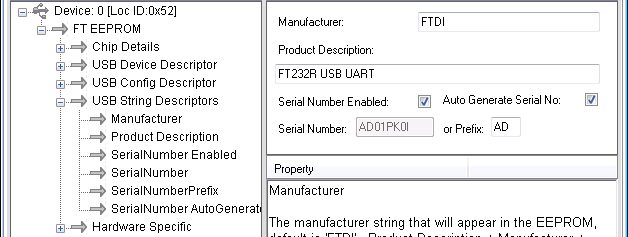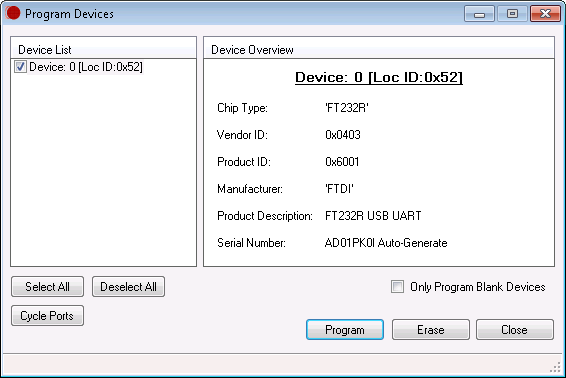- Get Started
- Learning
- Products
- Blog
- Beginner
For first time users of chipKIT modules. - Intermediate
For users who have a moderate exposure with chipKIT modules. - Advanced
For users who are experts with chipKIT modules. - Developers
- About Us
- Support
Identifying your chipKIT boards
Posted 2014-06-29 12:15:27 by Majenko One thing I find
annoying about the chipKIT boards is that when you plug them in they are
all identified as an "FTDI" chip. There's no way of knowing which
board is plugged in where, and if you have lots of boards (as I do),
then it would be really nice to know which COM port is which at a
glance.
One thing I find
annoying about the chipKIT boards is that when you plug them in they are
all identified as an "FTDI" chip. There's no way of knowing which
board is plugged in where, and if you have lots of boards (as I do),
then it would be really nice to know which COM port is which at a
glance.
Fortunately it is possible, if you happen to know how!
A little word of warning before I begin though - it is possible to kill your FT232R chip if you do things wrong, which will break your chipKIT board, so have a care and don't mess with things you shouldn't mess with.
Not many people know, but the FT232R chip used in most of the chipKIT (and other) boards is fully programmable by the end user. All you need is a little bit of software (alas only available for Windows) from FTDI called FT_Prog. It can be downloaded freely from here: FT_Prog_v2.8.2.0.zip
It requires .NET 4 to be installed, so if you don't have it you can grab it here: .NET 4.0
Once you have it installed you can load it up and tell it to scan for your devices (little magnifying glass in the toolbar). Make sure your board is plugged in at this point, and it should find it:

Select the "USB String Descriptors" section. It should look similar to this:

Now you can go ahead and edit the Manufacturer and Product Description entries to suit your needs. The board I have to hand is a MAX32, so I have changed them to:

Now you're all ready to reprogram the chip. The little lightning bolt in the toolbar does just that. Click it, and it opens a program panel:

Make sure the right device is selected (if you happen to have multiple boards connected), then press "Program". When it's finished (it only takes a second), you can close the window, then close the FT_Prog program. Unplug the board and plug it back in again. It will take a minute or so to reinstall the drivers (it may allocate a new COM port at this point as it thinks it's a different device), and it should now identify for what it is:

If it doesn't, try again. For some reason it took two attempts with my MAX32, but my PICadillo-35T did it first time.
Again, I must strongly reiterate: It is possible to break your FT232R chip with this utility, so don't play with anything other than the strings and you will be fine.
Oh, and don't blame me if you break it, it's not my fault.
